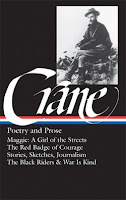From Stephen Crane: Prose & Poetry
Interesting Links
“Stephen Crane’s debut as a poet” (Christopher Benfey, Reader’s Almanac)
“The Red and the Scarlet: The hectic career of Stephen Crane” (Caleb Crain, The New Yorker)
Previous Story of the Week selections by Stephen Crane
• “The Bride Comes to Yellow Sky”
• “The Price of the Harness”
Buy the book
 Stephen Crane: Prose & Poetry
Stephen Crane: Prose & Poetry
Includes The Red Badge of Courage, Maggie, George’s Mother, The Third Violet, “The Monster,” other stories, journalism, poetry, and more
1,379 pages
List price: $50.00
Web store price: $35.00
“Stephen Crane’s debut as a poet” (Christopher Benfey, Reader’s Almanac)
“The Red and the Scarlet: The hectic career of Stephen Crane” (Caleb Crain, The New Yorker)
Previous Story of the Week selections by Stephen Crane
• “The Bride Comes to Yellow Sky”
• “The Price of the Harness”
Buy the book
 Stephen Crane: Prose & Poetry
Stephen Crane: Prose & PoetryIncludes The Red Badge of Courage, Maggie, George’s Mother, The Third Violet, “The Monster,” other stories, journalism, poetry, and more
1,379 pages
List price: $50.00
Web store price: $35.00
 |
| Winter Sports in the Gutter, 1875, oil on canvas by British-American painter John George Brown (1831–1913). Image courtesy of The Athenaeum. |
A few months before “The Monster” appeared, Crane went to Cuba to cover the Spanish American War and while on board the ship he wrote the second Whilomville tale, “His New Mittens.” At the end of May, in need (as always) of money, he sent the story to his agent and requested payment both for its magazine publication and for his next book. When his publisher hesitated paying for the book proposed by Crane, he wrote again, this time with despair tinged with anger:
I am all fuzzy with money troubles and last night a writ was served on me by a leading creditor. . . . I must have every pennie that you can wrest from the enemy. . . . Ask them why they don’t print “The Blue Hotel” and “His New Mittens” in one volume with the “Monster” and then pay up like little men. . . . I fail to see where they get such a hell of a right to decide as to what stories shall be published in a book that bears my name in a damn sight bigger type than it bears their imprint.The three stories finally appeared in December as The Monster and Other Stories. It was the last of Crane’s books published during his lifetime.
At first glance “His New Mittens” seems to be a somewhat sentimental tale about a young boy prohibited by his mother from participating in a snowball fight and taunted by the neighborhood gang: “A-fray-ed of his mittens!” An anonymous reviewer in the April 1900 issue of Book Buyer singled out this aspect of the story for praise: “Mr. Crane has made for himself a distinctive place among the interpreters of child life and the workings of the child mind.” But the poet John Berryman, who interviewed a number of Crane’s contemporaries, believed the impetus for the story occurred when Crane’s ship to Cuba stalked a Spanish destroyer and the captain loudly mocked his affectations of bravery, calling him a “damned frayed tholepin.” His fellow correspondents on the boat mercilessly mocked the “pajama-clad and sardonic” author, addressing him as “Lord Tholepin” until they were distracted by other events. In a recent biography, Paul Sorrentino likewise argues that readers can see “Crane’s thinly veiled disguise of himself”:
A waif like Horace? Crane had considered himself a loner since childhood. Exiled? He was persona non grata in New York City. Friendless? He had a few close friends, but believed he was destined to drift through life by himself. Poor? He had joined the Cuban campaign to defray his mounting debts in England.The year after leaving Cuba, Crane finished thirteen additional Whilomville pieces, which were published as a series in Harper’s, and he expressed the hope that all the stories set in his fictional town would eventually be gathered in a single volume. The new tales—without “The Monster” and “His New Mittens,” however—were published as Whilomville Stories two months after he died from tuberculosis in the spa town of Badenweiler, Germany, in June 1900. He was twenty-eight years old.
* * *
Little Horace was walking home from school, brilliantly decorated by a pair of new red mittens. A number of boys were snow-balling gleefully in a field. They hailed him. “Come on, Horace. We’re having a battle.” . . . If you don't see the full selection below, click here (PDF) or click here (Google Docs) to read it—free!This selection may be photocopied and distributed for classroom or educational use.